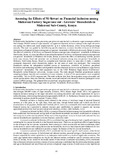| dc.description.abstract | In Kenya today the decline in cane production per given unit area has led to a domestic sugar consumption deficit
that averages 200,000 tonnes of sugar annually. An aggressive financial inclusion strategy in the sugar sub-sector
can sealing this deficit and create employment for up to 6 million Kenyans, whilst saving foreign exchange
annually. The study was guided by the following specific objectives; to assess the effect of access to M-Shwari
transactions on financial inclusion among cane out-growers’ households in Muhoroni sub-county, Kenya. to assess
the effect of suitability of M-Shwari on financial inclusion amongst cane out-growers’ households in Muhoroni
Sub-County, Kenya. to assess the effects of procedural formality of M-Shwari on financial inclusion amongst cane
out-growers’ households in Muhoroni sub-county, Kenya, to assess the effects of moderating variable; poverty
level, cane income, fiscal and monetary mix on financial inclusion among cane out-growers’ households in
Muhoroni Sub-County, Kenya. Based on comprehensive literature review on same area of study, a suitable
conceptual framework which dramatically depicts the key areas of study was developed. This conceptual
framework outlines the independent variables (access to transactions, suitability of m-shwari, procedural
formalities and moderating variables) and dependent variables (financial inclusion among Muhoroni sugar factory
out-growers’; households). The study population was all the 5,000 Muhoroni Sugar factory Out-Growers’
Households within Muhoroni sub-county, Kisumu county. The study adopted Stratified proportionate random
sampling technique that allowed construction of error estimates. A total of 366 questionnaires were completed
successfully. This is a 98.9% response rate. The study collected data from the respondent using open-ended and
closed questionnaires. Data was collected, cleaned, coded and analysed with the aid of statistical package for social
sciences (SPSS) package. The gathered data was analysed using descriptive statistics | en_US |

